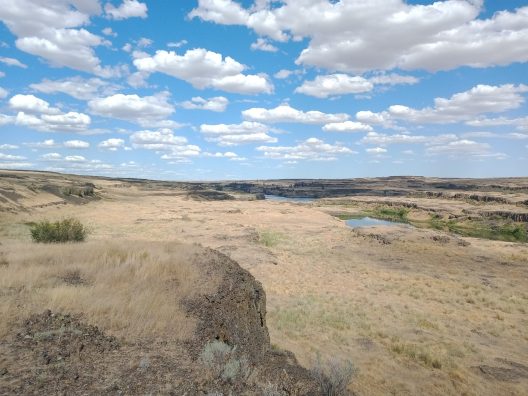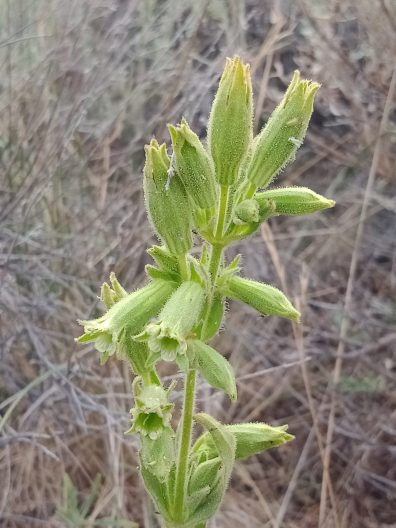On the Hunt for Spalding’s Catchfly

Out among the undulating biscuit and swale topography of the sagebrush-steppe in east-central Washington lives Spalding’s catchfly (Silene spaldingii). The basalt studded landscape feels vast and open under the blue skies of summer. For three weeks in August of 2023, you could find Allie Howell and I hiking between hundreds of patches of Spalding’s catchfly scattered over 50 square miles. Our task was to gather an updated population count after the devastating Whitney fire in 2020 that swept through a large section of the plant’s range in east-central Washington.
In 2023, we often found Spalding’s catchfly inhabiting the gentle northern slopes of ridges and the characteristic loess “biscuits” of the region, alongside Idaho fescue (Festuca idahoensis) and bluebunch wheatgrass (Pseudoroegneria spicata). It is a slender plant in the Caryophyllaceae (Pink) family, with subtle cream-colored flowers. These five-petaled flowers barely peek out from the long tube of its calyx. Its bright yellow-green stems and foliage are covered in dense, sticky hairs, hence the name “catchfly”. It can reach from six inches to two feet tall or more, with oppositely arranged leaves. Its distribution is varied, with some lone individuals found far from others, and some in swaths of one hundred or more in a good year. Spalding’s catchfly is a long- lived perennial which may regularly reach an age of at least 15 to 20 years. However, it is hypothesized some individuals may live up to 30 years or longer. (USFWS Recovery Plan, 2007).
This year, I returned to some of the 2023 survey locations. My mission: to collect seeds. Spalding’s catchfly has up to one hundred or more small, flat, and wrinkled chestnut-brown seeds, held in elongated, cup-like capsules with frilled serrations around the opening. If you have done seed collection before, you know it can be a bit of a gamble. When do you go, to avoid being too early or too late? How many plants will have bloomed and set seed this year? Will enough plants be found at each location to allow for a seed collection without compromising the population’s regeneration? This year, the cards dealt to us were not ideal. The first group I visited had 69 plants in 2023. This year I found six plants, five of which either were still in bloom, in fruit, or had already dispersed their seeds. Things were not as bleak at some of the next locations I visited in terms of number of plants, but many were already empty of seeds, completely senesced, or had been browsed and lacked capsules entirely. Still, all in all I was able to collect seeds from around 50 plants from the three populations combined. Some plants with a large number of capsules (up to 60 or more from plants with multiple stems) even had quite a generous number of seeds.

Do not lose hope for the fate of the Spalding’s catchfly, however. While its numbers were low this year, a demographic study in Montana found Spalding’s catchfly exhibits prolonged or summer dormancy; that is, plants can remain alive below the ground, without leaves, for up to 6 years when conditions are unfavorable (Lesica and Crone, 2007). We speculate that the hot, dry spell in Eastern Washington in late spring and early summer dissuaded many of the plants from venturing above ground this year. We plan to return in subsequent summers to gather more seeds from the populations of Spalding’s catchfly, hoping to catch the plant in a less “sleepy” year.
After a decade working in ecological restoration, beginning in southwestern Ohio then coming out to the Pacific Northwest, Teddy Pierson decided to dive deeper into the conservation research side of ecology. Teddy has greatly enjoyed the last two summers spent as Rare Care’s Botany Field Technician, during which they have learned a great many new skills and seen many exciting new plants and areas of Washington. Teddy is looking forward to beginning a master’s program in plant ecology in 2025.